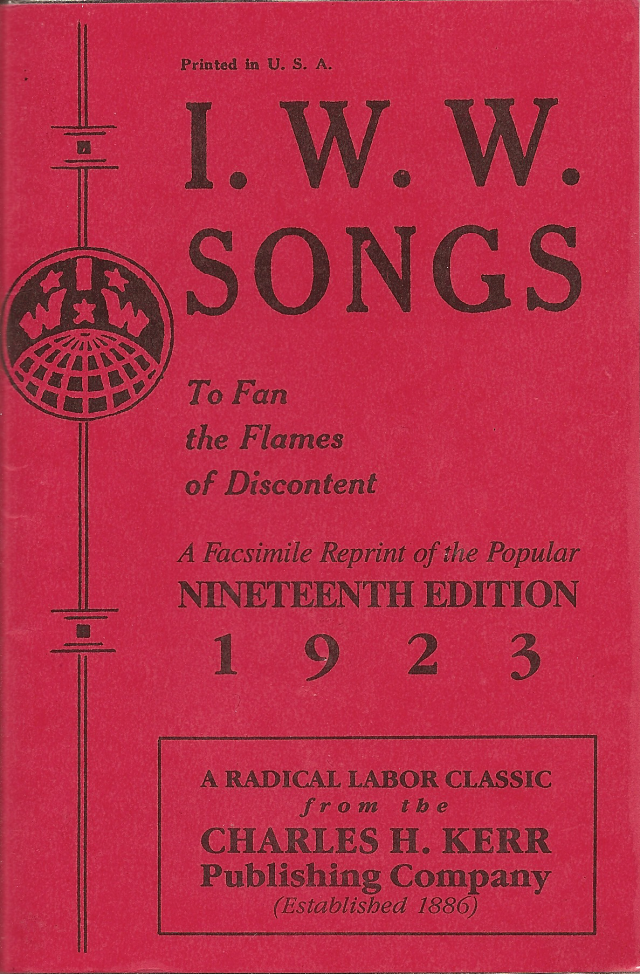Allegro
Creativity in the Ongoing Struggle for Change
Celebrating Labor History Month
Volume 123, No. 5May, 2023

The “little red book” is still a classic songbook of labor anthems and songs
The art of rebellion is a tradition as old as dissent itself. Radical writers, musicians, painters, actors, dancers and other creative activists have long used their artwork as a weapon in the fight for social justice. If the very nature of expressive freedom lends itself toward a revolutionary voice, then it is arguable that the arts gave birth to radicalism, or in the least offered a vision toward its path. And the cultural workers fight for his or her own freedom of expression — and against the confines of censorship — further exemplifies the voice of creativity in this good fight.
One can easily look to the works and dreams of revolutionary artists of every stripe to see the connection within the fight for workplace justice and social change. However, the artists who have guided their repertoire into progressive struggles and real-time issues, move into a specific realm, one beyond art for its own sake. Such creative activists extend the possibilities of the political pamphlet by leaps and bounds. They have the power to put melody to fiery speeches and add a universe of color to the black-and-white of dogma. They add the necessary ingredient of emotion to demonstrators’ placards and hold the history of revolutionary art within their hands.
In analyzing the breadth of cultural work, eras of advanced struggle clearly produce artists — and artforms–of striking radicalism. The people have faced brutal labor struggles as well as virulent racism, misogyny, anti-Semitism, and xenophobia. But we’ve also been riddled with reactionary governmental repression when the people use our very rights of free expression.
Throughout the epochs cultural workers can be credited with beating swords into revolutionary instruments. The Industrial Workers of the World, in its founding year of 1905, counted song, visual art, poetry and muckraking journalism among its strongest assets, second only to its racially mixed board which included women. Legends Joe Hill, Mac McClintock and Ralph Chaplin, and later Utah Phillips, and Dave van Ronk are still recalled as cores of the movement.
On October 24, 1929, in the throes of the world’s worst financial disaster, following years of expansive monopoly capital, greed and avarice, waves of unrest and fascism were spreading violently across the globe. Cultural workers not only offered their radical artistic visions to the bruised landscape, but actively engaged in the street-heat for democracy and change. The John Reed Club, Poor Peoples Marches, fights against lynchings and discrimination, bloody union strikes and intense organizing actions, May Day Parades, educational seminars and tutelage, and a wide swath of political battles fused into the Workers Music League, the Red Dancers, the League of American Writers, “The New Masses” magazine, the Film and Photo League, “Partisan Review” journal, the League of American Artists and several international Congresses of Writers and Artists. Later organizations that featured cultural workers on the front lines included People’s Songs, the Black Panther Party, and the Young Lords. The NYC- and Newark-based Black Arts Movement spawned Chicago’s Association for the Advancement of Creative Musicians, St. Louis’ Black Artists Group and LA’s Union of God’s Musicians and Artists’ Ascension. By the ‘70s, New York saw the founding of the Jazz Composers Orchestra Association among other groups engaged in the struggle.
Over more than a century, cultural programs of the American Left, often shoulder-to-shoulder with labor organizations, were widespread and became entrenched in every fight for social change. A small sample of the musicians and writers recalled for their tireless fight include (in no particular order) Paul Robeson, Leonard Bernstein (802), Langston Hughes, Marc Ribot (802), John Reed, James Baldwin, Leadbelly, Pete Seeger (802), Horace Tapscott, Woody Guthrie, Hazel Scott (802), Carl Sandburg, Charles Mingus (802), Phil Ochs, Amiri and Amina Baraka, John Lennon (802), Gil Scott Heron, Richard Wright, Isadora Duncan, Rose Pastor Stokes, Duke Ellington (802), Carla Bley (802), Dalton Trumbo, Billy Bang, Patti Smith, Arturo O’Farrill, Phil Ochs (802), Billy Strayhorn (802), Michael Gold, Archie Shepp (802), Tillie Olson, Karl Berger (802), Claude McKay, Aaron Copland (802), Cal Massey, Dashiell Hammett and a breathtaking array of others.
It’s inspiring to recall that Ellington’s celebrated musical, “Jump for Joy: A Sun-Tanned Revu-sical” was intended by the composer as a means “to take Uncle Tom out of the theatre, eliminate the stereotyped image that had been exploited by Hollywood and Broadway, and say things that would make the audience think.” And Billie Holiday’s immortal recording of Marxist poet and songwriter Abel Meeropol’s “Strange Fruit” may have said more to listeners than whole discographies by others.
Far too many of our strongest cultural workers, in and out of the labor movement, suffered the pains of the House Un-American Activities Committee, the multi-industry Blacklist, various police department “red squads”, the FBI and COINTELPRO ops, even decades later. That right-wing Cold War putsch starting in 1947 and strengthened through the ‘50s came with a weakening of labor laws and a concerted effort to diminish the collective power of workers. As a result, many radical arts institutions were torn apart by excruciating conflicts within and without, but the movement is tireless, and we’ve seen new cultural fight-back arrive with each decade. The lure of creativity is compelling and the legacy of these powerful figures of revolutionary creativity remains insurmountable. So, yes, we’re gonna roll the union on!
- For more info on Joe Hill and the IWW: http://theculturalworker.blogspot.com/2010/12/brief-revolutionary-life-of-joe-hill.html
- For more info on Paul Robeson: http://theculturalworker.blogspot.com/2011/04/paul-robeson.html
- For more info on Billie Holiday and “Strange Fruit”: http://theculturalworker.blogspot.com/2015/03/the-pervasive-reality-of-strange-fruit.html
- For more info on labor songs: https://www.thenation.com/article/archive/top-ten-labor-day-songs/
John Pietaro is Local 802’s director of organizing as well as a published poet and journalist. You can reach him at jpietaro@local802afm.org or (212) 245-4802, ext. 230
